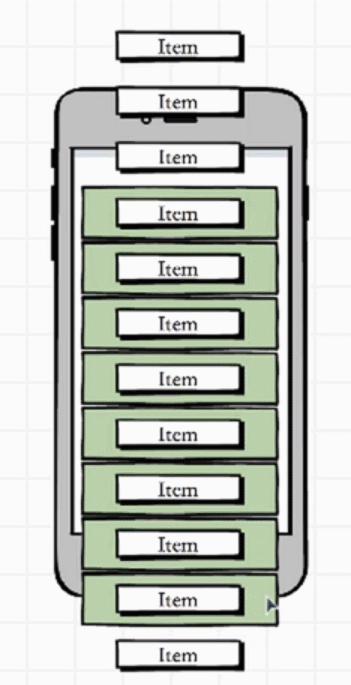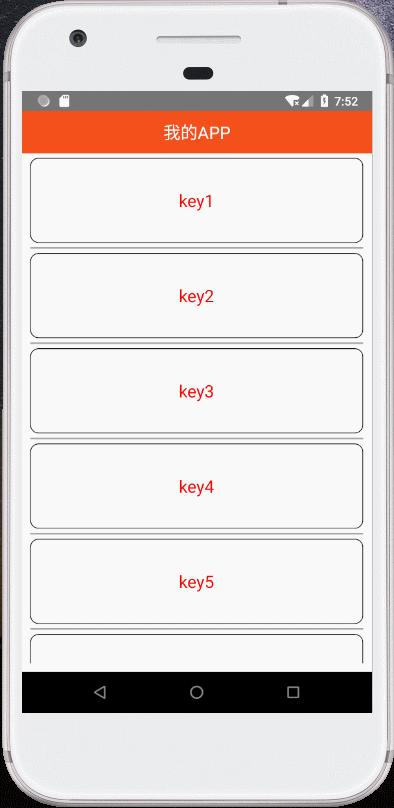react-native系列(9)组件篇:最优列表显示方案FlatList和SectionList
FlatList列表
FlatList是一个高性能的列表组件。原理是:只负责渲染当前可见的列表项,对于不可见的项将不会渲染因为可见的项总是有限的,当一个项被划出屏幕后,被滑出项的容器将会成为新滑入的项的容器而不会重新再渲染一个,因此性能要比ScrollView和ListView组件高。
下面是一个原理简图:
FlatList的属性和方法:
| 属性 | 描述 |
| style |
显示样式 |
| data |
数据源,格式为对象数组,如[{key:1},{key:2}] |
| renderItem |
列表项渲染函数,数据来源于数据源遍历出的每个对象 |
| showsVerticalScrollIndicator |
当此属性为true的时候,显示一个垂直方向的滚动条,默认为: true |
| showsHorizontalScrollIndicator |
当此属性为true的时候,显示一个水平方向的滚动条,默认为: true |
| pagingEnabled |
当值为true时,滚动条会停在滚动视图的尺寸的整数倍位置。默认为: false |
| ItemSeparatorComponent |
行与行之间的分隔线组件。不会出现在第一行之前和最后一行之后 |
| ListEmptyComponent |
列表为空时渲染该组件。可以是 React Component, 也可以是一个 render 函数,或者渲染好的 element |
| ListFooterComponent |
列表尾部组件。可以是 React Component, 也可以是一个 render 函数,或者渲染好的 element |
| ListHeaderComponent |
列表头部组件。可以是 React Component, 也可以是一个 render 函数,或者渲染好的 element |
| numColumns |
多列布局只能在非水平模式下使用,即必须是horizontal={false}。此时组件内元素会从左到右从上到下按 Z 字形排列。如numColumns = {2}表示列表显示两列 |
| columnWrapperStyle |
当numColumns大于1时才可用,表示指定此样式作用在每行容器上。如{{backgroundColor:'red'}} |
| horizontal |
设置为 true 则变为水平布局模式,默认为: false |
| initialNumToRender |
指定一开始渲染的元素数量,最好刚刚够填满一个屏幕,这样保证了用最短的时间给用户呈现可见的内容。注意这第一批次渲染的元素不会在滑动过程中被卸载,这样是为了保证用户执行返回顶部的操作时,不需要重新渲染首批元素 |
| inverted |
翻转滚动方向 |
| onEndReachedThreshold |
决定当距离内容最底部还有多远时触发onEndReached回调,范围0~1,如0.01表示触底时触发 |
| onEndReached |
在列表底部往下滑时触发该函数。表示当列表被滚动到距离内容最底部不足onEndReachedThreshold的距离时调用 |
| scrollEnabled |
当为false时表示禁止滚动,默认为: true |
| onMomentumScrollBegin |
滚动惯性动画开始时触发的函数 |
| onMomentumScrollEnd |
滚动惯性动画结束时触发的函数 |
| onScrollBeginDrag |
拖拽开始时触发的函数 |
| onScrollEndDrag |
拖拽结束时触发的函数 |
| onRefresh |
在列表顶部往下滑时触发该函数。如果设置了此选项,则会在列表头部添加一个标准的RefreshControl控件,以便实现“下拉刷新”的功能,此时显示的loading符号为默认样式,需要自定义样式可使用refreshControl |
| refreshing |
在等待加载新数据时将此属性设为 true,列表就会显示出一个正在加载的符号,此时显示的loading符号为默认样式,需要自定义样式可使用refreshControl |
| refreshControl |
RefreshControl组件,可以自定义loading符号的样式,(该属性在中文官网中没有找到,应该是作者忽略了) |
| 方法 | 描述 |
| scrollToEnd() |
滚动到最底部 |
| scrollToIndex() |
将位于索引值为index的元素滚动到可视区域首行位置,如scrollToIndex({animated: true, index:10}); |
| flashScrollIndicators() |
短暂地显示滚动指示器 |
贴上代码:
import React, { Component } from 'react';
import { View, Text, FlatList, StyleSheet,RefreshControl } from 'react-native';
class FlatListComp extends Component {
state = {
list: [],
refreshing: false
};
componentDidMount(){
// 初始化数据
let list = [];
for(var i = 0; i < 8; i++) {
list.push({key: 'key'+(i+1)});
}
this.setState({list: list});
}
// 渲染列表项
_renderItem = ({index, item}) => {
console.log(index);
return (
{item.key}
);
}
// 分割线
_renderSeparator = () => {
return (
class Separator extends Component {
render(){
return (
没有数据时显示本段文字
);
}
// 底部加载
_onEndReached = () => {
this.setState({refreshing: true});
// 关于更新state里数组的两种方式
//setState({ 'arrary': [...this.state.array, newItem]}).
//setState({ 'array' : [...this.state.array].concat(newList|newItem)}).
let newList = [];
for(var i = 0; i < 3; i++) {
newList.push({key: '(new)key'+ Math.floor(Math.random() * 10000)});
}
setTimeout(()=>{
this.setState({list: [...this.state.list].concat(newList), refreshing: false});
},2000);
}
// 顶部加载
_onRefresh = () => {
this.setState({refreshing: true});
setTimeout(()=>{
this.setState({refreshing: false});
// this.myFlatList.scrollToEnd(); // 滚动到底部
// this.myFlatList.scrollToIndex({animated: true, index:10}); // 将位于索引值为index的元素滚动到可视区域首行位置
// this.myFlatList.flashScrollIndicators(); // 短暂地显示滚动指示器
},2000);
}
render() {
console.log(this.state.list);
return (
我的APP
{ this.myFlatList = view; }}
data={this.state.list} // 数据源
renderItem={this._renderItem} // 从数据源中挨个取出数据并渲染到列表中
showsVerticalScrollIndicator={false} // 当此属性为true的时候,显示一个垂直方向的滚动条,默认为: true
showsHorizontalScrollIndicator={false} // 当此属性为true的时候,显示一个水平方向的滚动条,默认为: true
ItemSeparatorComponent = {this._renderSeparator()} // 行与行之间的分隔线组件。不会出现在第一行之前和最后一行之后
ListEmptyComponent = {this._renderListEmptyComp()} // 列表为空时渲染该组件。可以是 React Component, 也可以是一个 render 函数,或者渲染好的 element
onEndReachedThreshold={0.01} // 决定当距离内容最底部还有多远时触发onEndReached回调,范围0~1,如0.01表示触底时触发
onEndReached={this._onEndReached} // 在列表底部往下滑时触发该函数。表示当列表被滚动到距离内容最底部不足onEndReachedThreshold的距离时调用
refreshControl={
);
}
}
const styles = StyleSheet.create({
scrollViewStyle: {
flex: 1,
marginLeft:10,
marginRight: 10,
marginBottom: 10
},
headerViewStyle: {
height: 50,
backgroundColor: '#f4511e',
justifyContent: 'center',
alignItems: 'center'
},
headerTextStyle: {
fontSize: 20,
color: '#FFFFFF'
},
itemViewStyle: {
height: 100,
borderWidth: 1,
borderRadius: 10,
marginTop: 5,
justifyContent: 'center',
alignItems: 'center'
},
itemTextStyle: {
color: 'red',
fontSize: 20
},
separatorStyle: {
borderColor: '#A4A4A4',
borderBottomWidth: 2,
marginTop: 5
}
});
export default FlatListComp;效果:
小贴士:由于加载的loading符号形状是不可变的,如果你想要更个性化的列表组件,可以尝试使用第三方插件 react-native-pull 。
SectionList列表组
SectionList列表组和FlatList的原理是差不多的,在显示上,每个组里的项就是一个列表,要注意的是数据源格式的不同。
数据源的格式如下所示:
datasource=[
{
title:'section1',
...
data:[
{key:1},
{key:2}
]
}, ...]在属性和方法上,大部分也和FlatList一样的,相同的这里就不列出来了。SectionList特有的属性和方法:
| 属性 | 描述 |
|---|---|
| sections |
列表组数据源 |
| renderSectionHeader |
每个组的头部组件 |
| renderSectionFooter |
每个组的尾部组件 |
| stickySectionHeadersEnabled |
当下一个section把它的前一个section的可视区推离屏幕的时候,让这个section的header粘连在屏幕的顶端。默认为: false |
| SectionSeparatorComponent |
组与组之间的分割线组件 |
| 方法 | 描述 |
|---|---|
| scrollToLocation() |
将位于索引值为sectionIndex中itemIndex的元素滚动到可视区域首行位置,如scrollToLocation({animated: true, itemIndex:2, sectionIndex:1}); |
贴上代码(本demo中代码有点多,因为列出了所有的列表组属性,请仔细看):
import React, {Component} from 'react';
import { View, Text, SectionList, StyleSheet, RefreshControl } from 'react-native';
class SectionListComp extends Component {
state = {
sections: [],
refreshing: false
};
componentDidMount() {
let sections = [];
for(var i = 0; i < 4; i++) {
let section = {};
section.title = '列表组'+ (i+1);
section.data = [];
for(var n = 0; n < 5; n++) {
let item = {};
item.key = 'key' + (n+1);
section.data.push(item);
}
sections.push(section);
}
this.setState({sections: sections});
}
_renderSectionHeader = ({section: {title}}) => {
return (
{title}
);
}
_renderItem = ({ item, index, section }) => {
return (
{item.key}
);
}
_renderListEmptyComp = () => {
return (
没有数据时显示本段文字
);
}
// 分割线
_renderSeparator = () => {
return (
class Separator extends Component {
render(){
return (
我的APP
{ this.mySectionList = view; }}
style={styles.scrollViewStyle}
sections={this.state.sections}
renderItem={this._renderItem}
renderSectionHeader={this._renderSectionHeader} // 每个组的头部组件
renderSectionFooter={()=>{}} // 每个组的尾部组件
ListHeaderComponent = {()=>
);
}
}
const styles = StyleSheet.create({
scrollViewStyle: {
flex: 1,
marginLeft: 10,
marginRight: 10
},
headerViewStyle: {
height: 50,
backgroundColor: '#f4511e',
justifyContent: 'center',
alignItems: 'center'
},
headerTextStyle: {
fontSize: 20,
color: '#FFFFFF'
},
titleViewStyle: {
backgroundColor: '#E4E4E4',
marginTop: 20,
height: 30,
justifyContent: 'center',
alignItems: 'center'
},
titleTextStyle: {
color: 'red',
fontSize: 24
},
itemViewStyle: {
height: 70,
borderWidth: 1,
borderRadius: 10,
marginTop: 5,
justifyContent: 'center',
alignItems: 'center'
},
itemTextStyle: {
color: 'red',
fontSize: 20
},
separatorStyle: {
borderColor: 'blue',
borderBottomWidth: 1,
marginTop: 5,
marginBottom: 5
}
});
export default SectionListComp;效果:

